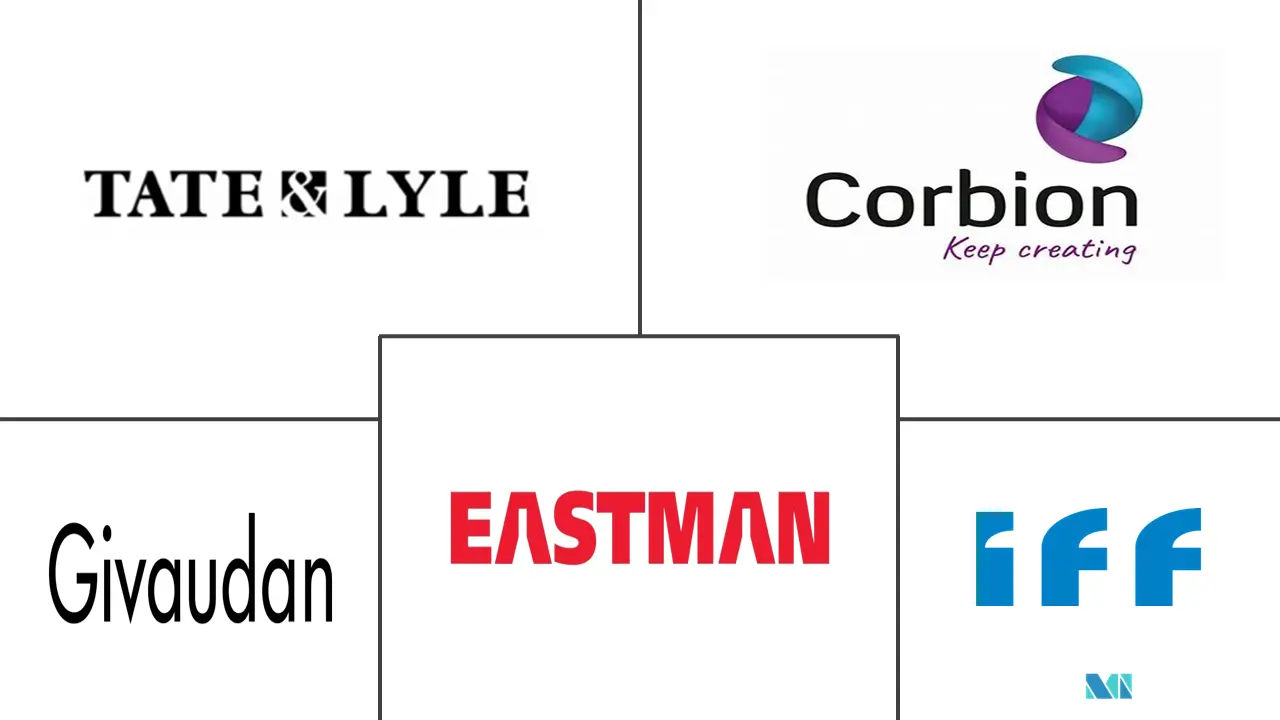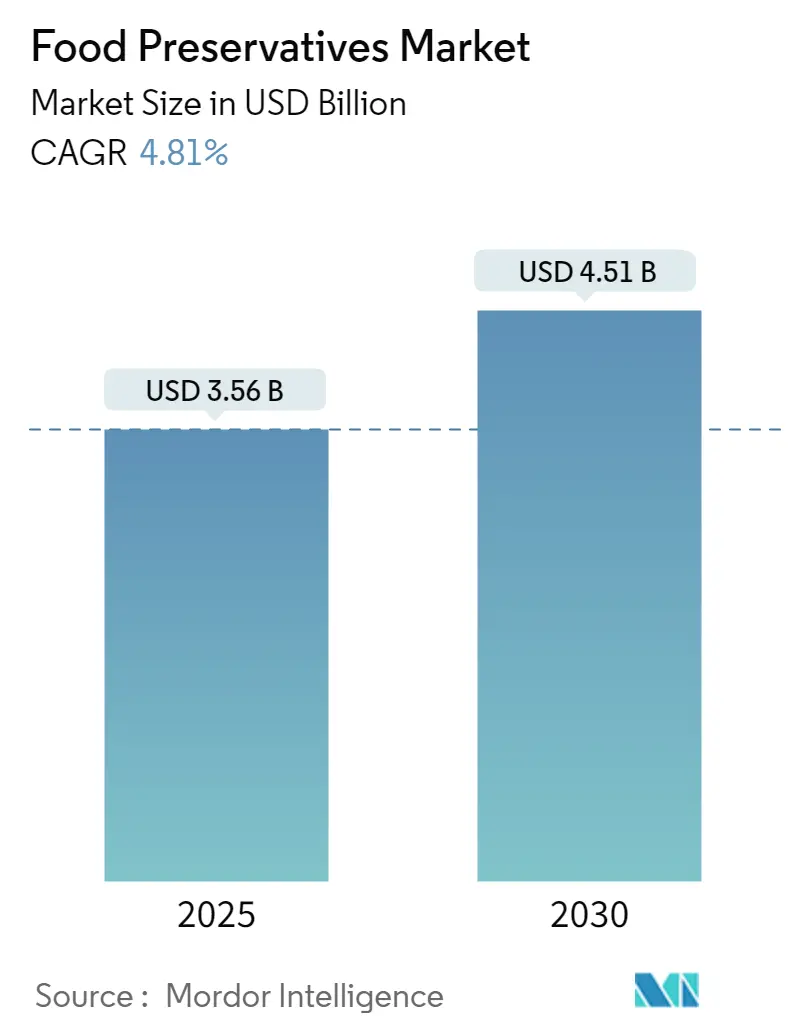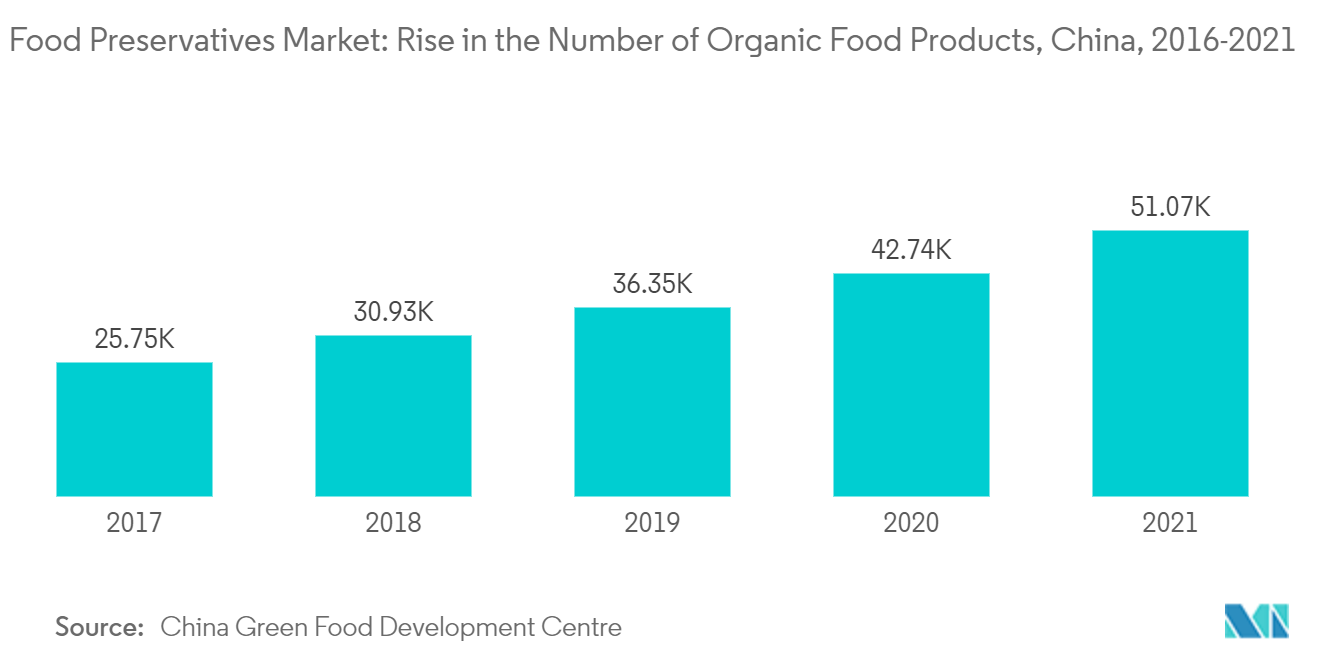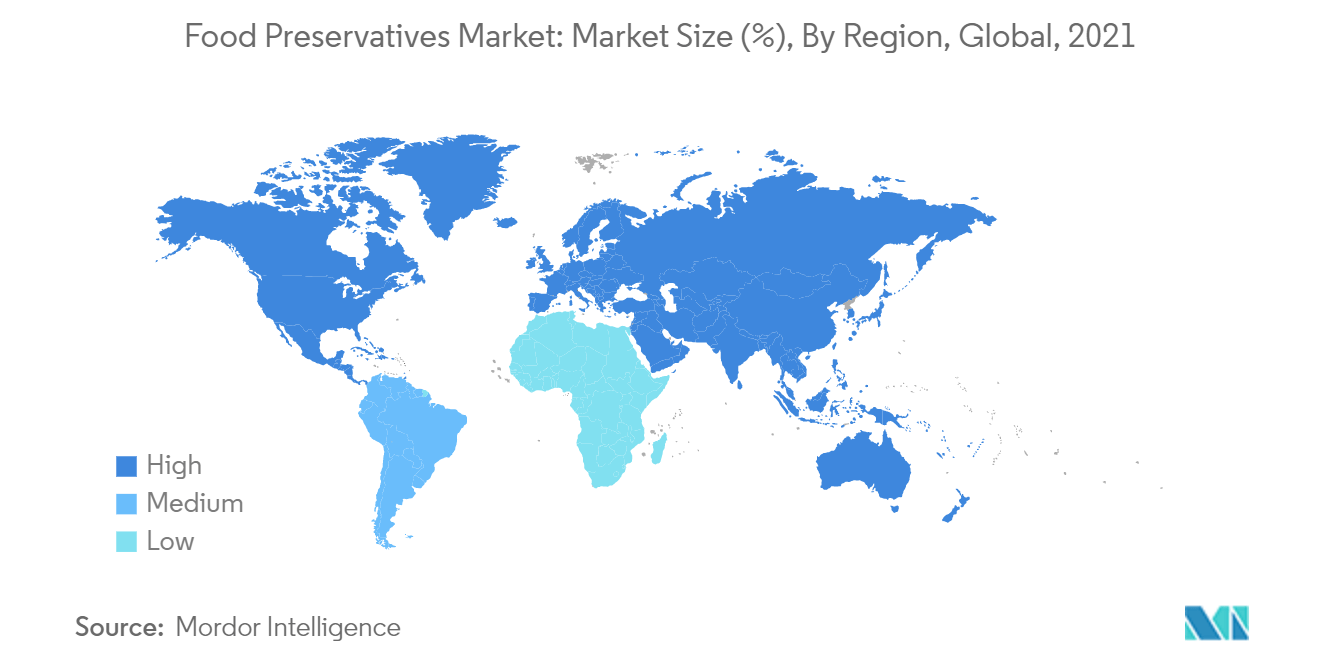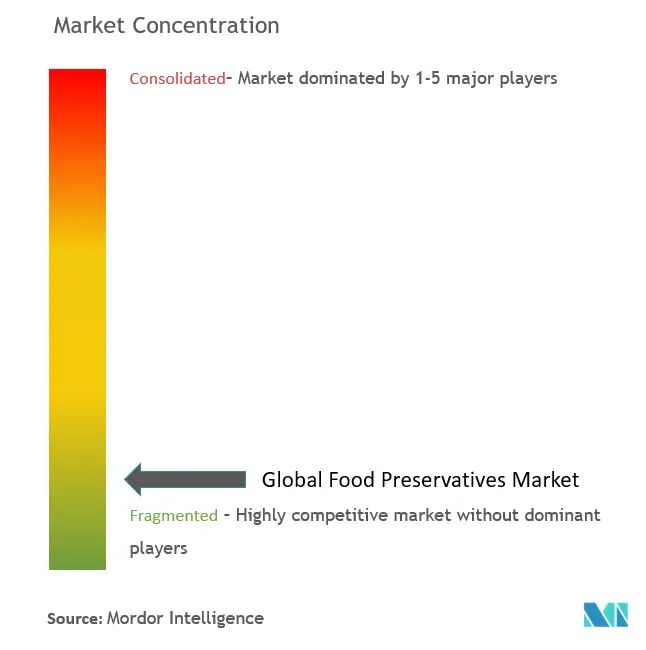Food Preservatives Market Analysis
The Food Preservatives Market size is estimated at USD 3.56 billion in 2025, and is expected to reach USD 4.51 billion by 2030, at a CAGR of 4.81% during the forecast period (2025-2030).
The COVID-19 outbreak led to elevated sales of retail and long-shelf products across the global market due to restrictions on going out. Hence, the majority of the population across the world is engaged in stockpiling groceries and packaged food products for their households. This eventually had a positive impact on the industrial demand for food preservatives because of the rise in demand for processed food. Also, there has been a rise in the number of people who want ready-to-eat (RTE) meals, which has opened up new opportunities for companies that make food preservatives.
The strong correlation between the food preservatives market and the processed food market is driving the growth of the market, as there is a rise in the demand for processed food globally. The demand for food preservatives has gone up because they are used in more food industries.The antimicrobial and antioxidant properties of these food preservatives make them necessary for the food industry to make products last longer and stop bacteria from doing things they shouldn't.Sorbate, for example, is thought to be a good food preservative when it is used in a clean environment and in products that are made using good manufacturing practices.Sorbates are used a lot to make processed foods and drinks last longer. They are also used to make sausages, yogurt, cheese, cakes, and a lot of other things. Sorbates also stop different types, species, strains, substrate properties, and environmental factors from making microorganisms grow.Moreover, different regulatory agencies like the Food and Drug Administration, the Food and Agriculture Organization, and the European Food Safety Authority have put forward guidelines that say potassium sorbate is "generally regarded as safe", which is abbreviated as GRAS. The preservative doesn't accumulate in the body and passes through it.
The market is driven by the growing need for clean label solutions, the rising popularity of processed and packaged foods, and the complexity of the food industry's supply chain. The food preservatives market is likely to be driven by the growth of organized retail, especially in emerging markets. The major restraints on the market include the higher cost of natural preservatives (which are in higher demand) and consumer awareness of the side effects of synthetic preservatives. For example, Corbion NV increased its production of lactic acid and products made from lactic acid in March 2021 by working on expansion projects at the same time in Europe and other places.
Food Preservatives Market Trends
Surge in Demand for Clean Label Food Products
As the need for natural antioxidants, antimicrobials, and other natural food preservatives has grown, so has the need for "clean label" foods. Consumers are becoming more health conscious, preferring products with clean labels over those with artificial ingredients. Consumers are frequently checking the ingredients of products before buying them. There are high expectations among consumers globally that food products, including meat and poultry, should have clean-label ingredients. This growing consumer concern is pushing them much further down the value chain, back to the ingredients, and increasing demand for natural food preservatives. The food preservative manufacturers have also adapted the production of clean-label additives that can be helpful when developing clean-label products. These clean-label preservatives have found their applications in varied food products and other applications. Thus, food and beverage manufacturers are also increasingly reformulating their products to meet the changing consumer demand for natural ingredients. For instance, Millbo, an Italy-based company, got nominated for the Fi Europe Innovation Award 2021 for the creation of a natural ingredient, namely X-Tra Guard, which eliminates the need for sorbic acid preservatives.
So, using ingredients with clean labels also helps companies with their marketing and branding. As people want to know more about the ingredients and additives in the food they eat, the market for clean-label food preservatives is expected to grow quickly during the forecast period.
North America Holds the Maximum Share in the Market
The rising demand for convenience and processed foods is propelling manufacturers to use food preservatives to enhance the shelf life of food products. Moreover, North America is a major exporter of fruits, thus increasing the demand for preservatives. Awareness related to several risks associated with chemical preservatives has driven the market for natural preservatives. North America has highly regulated policies with respect to the commercialization of food products and ingredients. Such regulations have offered lucrative growth opportunities for manufacturers to introduce novel preservatives with minimal or no side effects on human health. As a part of their strategy, the companies are spending significant amounts on developing techniques to produce preservatives using more natural ingredients than synthetic inputs. For instance, in 2021, Corbion NV was granted a European patent for its fruit ferment, which contains natural organic acid and other flavor components and has wide application in different food industries, like a bakery. This patent is extended to the United States.
The demand for clean-label products has been escalating the demand for natural preservatives. Consumers' added concern about artificial preservatives and flavor enhancers has led manufacturers to reformulate their products. The growth of this segment of the market may also be attributed to the increasing acceptance of natural preservatives by different government organizations. Further, as an illustration, Canadian consumers' shift towards organic food and beverages is driving the demand for natural food additives including preservatives. For instance, Natural Products Canada announced a USD 50 billion investment fund in 2021 to help early-stage Canadian businesses create naturally derived substitutes for synthetic products in order to boost the penetration of natural ingredients and replace their synthetic counterparts.
Food Preservatives Industry Overview
The food preservatives market is highly fragmented and competitive, with the presence of many global players. The most active companies globally include Eastman Chemical Company, International Flavors & Fragrances Inc., Tate & Lyle PLC, Givuadan SA, and Corbion NV. To strengthen their market position, these players have focused on product innovations, expansions, and partnerships. These players have a strong position in the fast-growing natural preservatives and clean label categories, benefiting from greater usage of these preservatives in foods and beverages generally. The strategy of developing new products and partnerships with local players helps to increase the company's footprint in the foreign country and release new products according to the consumers' changing preferences.
Food Preservatives Market Leaders
-
Eastman Chemical Company
-
Tate & Lyle PLC
-
Givuadan SA
-
Corbion NV
-
International Flavors & Fragrances Inc.
- *Disclaimer: Major Players sorted in no particular order
Food Preservatives Market News
July 2022: Kemin Industries Inc. launched a new food preservative, RUBINITE GC Dry, as a substitute for sodium nitrite. As per the company, RUBINITE is a natural alternative that can be used as a curing agent in foods, offering the best microbiological protection and maintaining product stability. Furthermore, Kemin Industries intends to employ it in processed meat products like sausages and hot dogs.
March 2022: DSM launched DelvoGuardcultures, targeting producers looking for clean-label solutions while also providing them with a solution to extend the shelf life of their dairy products such as yogurt, fresh cheese, and sour cream.
November 2021: Tate & Lyle PLC announced the construction of a new biomass boiler at its acidulants plant in Santa Rosa, Brazil.
April 2021: Kemin Industries Inc. expanded its distribution agreement with Diethelm Keller Siber Hegner (DKSH) to include distribution for Kemin Food Technologies Asia in the Philippines and Indonesia.
Food Preservatives Industry Segmentation
Food preservatives are substances or chemicals that are added to foods and drinks to stop them from breaking down due to chemical reactions that aren't good.These substances hinder the growth of microbial action in food substances.
The food preservative market is segmented by type, application, and geography. By type, the market is segmented into antioxidants, antimicrobials, acidulants, and other types. Both antioxidants and antimicrobials are further categorized on the basis of their natural and synthetic forms. Based on application, the market is segmented as follows: bakery and confectionery; meat and poultry; ready meals; sweet and savory snacks; sauces and dressings; edible oils; and other applications. The market is segmented on the basis of geography into North America, Europe, Asia-Pacific, South America, the Middle East, and Africa. For each segment, the market sizing and forecasts have been done on the basis of value (in USD million).
| Type | Antioxidants | Natural Antioxidants | |
| Synthetic Antioxidants | |||
| Antimicrobials | Natural Antimicrobial | ||
| Synthetic Antimicrobial | |||
| Acidulant | |||
| Other Types | |||
| Application | Bakery and Confectionery | ||
| Meat and Poultry | |||
| Ready Meals | |||
| Sweet and Savory Snacks | |||
| Sauces and Dressings | |||
| Edible Oils | |||
| Other Applications | |||
| Geography | North America | United States | |
| Canada | |||
| Mexico | |||
| Rest of North America | |||
| Europe | Spain | ||
| United Kingdom | |||
| Germany | |||
| France | |||
| Italy | |||
| Russia | |||
| Rest of Europe | |||
| Asia-Pacific | China | ||
| Japan | |||
| India | |||
| Australia | |||
| Rest of Asia-Pacific | |||
| South America | Brazil | ||
| Argentina | |||
| Rest of South America | |||
| Middle-East and Africa | South Africa | ||
| United Arab Emirates | |||
| Rest of Middle-East and Africa | |||
Food Preservatives Market Research FAQs
How big is the Food Preservatives Market?
The Food Preservatives Market size is expected to reach USD 3.56 billion in 2025 and grow at a CAGR of 4.81% to reach USD 4.51 billion by 2030.
What is the current Food Preservatives Market size?
In 2025, the Food Preservatives Market size is expected to reach USD 3.56 billion.
Who are the key players in Food Preservatives Market?
Eastman Chemical Company, Tate & Lyle PLC, Givuadan SA, Corbion NV and International Flavors & Fragrances Inc. are the major companies operating in the Food Preservatives Market.
Which is the fastest growing region in Food Preservatives Market?
Middle East and Africa is estimated to grow at the highest CAGR over the forecast period (2025-2030).
Which region has the biggest share in Food Preservatives Market?
In 2025, the North America accounts for the largest market share in Food Preservatives Market.
What years does this Food Preservatives Market cover, and what was the market size in 2024?
In 2024, the Food Preservatives Market size was estimated at USD 3.39 billion. The report covers the Food Preservatives Market historical market size for years: 2019, 2020, 2021, 2022, 2023 and 2024. The report also forecasts the Food Preservatives Market size for years: 2025, 2026, 2027, 2028, 2029 and 2030.
Our Best Selling Reports
Feed Preservatives Industry Report
Statistics for the 2025 Food Preservatives market share, size and revenue growth rate, created by Mordor Intelligence™ Industry Reports. Food Preservatives analysis includes a market forecast outlook for 2025 to 2030 and historical overview. Get a sample of this industry analysis as a free report PDF download.

